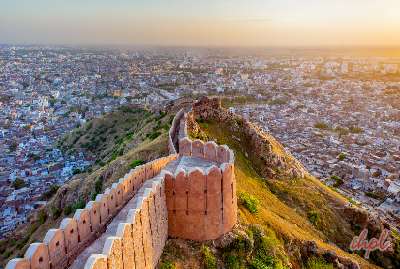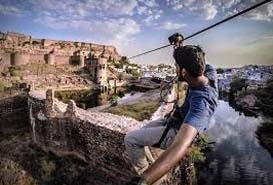The Haveli fresco art, a unique feature of the Shekhawati region in Rajasthan, is much of Shekhawati’s claim to fame. The famous miniature painting of Shekhawati, is a very important aspect of Rajput School of Art and finds most celebrated expression in the frescos and murals on the havelis in the region. The most beautiful havelis in Shekhawati are to be seen in Fatehpur, Dundlod, Nawalgarh, Mukundgarh and Jhunjhunu. The Jagannath Singhania Haveli Fatehpur is one of the best preserved Havelis in Fatehpur.
Often known as the ‘open art gallery of Rajasthan’, Shekhawati has some of the best havelis in Rajasthan. These havelis are storehouses of the celebrated miniature paintings of Rajasthan- that can be witnessed in their murals and frescos. The Miniature painting as we see now, expanded to the regional kingdoms of Rajasthan predominantly after the downfall of the Mughals.
The Rajput miniatures trace their origins to the Mughals, who appointed Rajasthani artists to adorn their monuments; these artists in turn brought the art form home, which flourished under the princely patronage. The Mughal influence very prominent in the beginnings, slowly gave way to regional block motifs. Even to this day, the classical element and aura of these paintings survive at the hands of the successors of the erstwhile artisans.
The Jagannath Singhania Haveli In Fatehpur India was built in the 19th century. It belongs to the Singhania family who were eminent merchants in the area. The Jagannath Singhania Haveli In Rajasthan India was used by the Singhania family as their residence.
Most of the havelis in Fatehpur and also in the Shekhawati region were built between the 18th century and the early decades of the 20th century. These havelis belonged to the rich merchants of the region, who were almost very influential in the local financial arena which led them to have considerable influence on the local administration as well.
Much of the local people’s lives were dependent on these merchants, locally called Seths. The havelis built by these merchants for most part acted as their status symbol.
However, after the independence, for lack of any one to look after them, and to cope up with the rising maintenance cost, many of these havelis were turned into heritage hotels, while others lie obscured in the company of caretakers. Few of the havelis like the Jagannath Singhania Haveli Fatehpur have also been opened to the public for an entry fee.
The frescos on the walls of the Jagannath Singhania Haveli In Fatehpur Rajasthan show thematic transition of the fresco art as a result of the socio historical changes that marked the Rajasthani society then. While some of the frescos show the pictures of Radha and Krishna, in their romance, their love games, and sweet nothings; some others depict Englishmen with guns, reflective of the common native association of the Englishmen with firearms.












